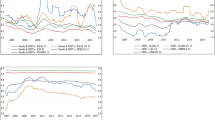Abstract
Financial institutions are typically tied together via inter-liability, portfolio overlapping and share cross-holding. These connections among financial institutions constitute the three most common financial networks, which may lead to financial risk contagion and even systemic risk when some institutions suffer shock. In this paper, firstly, for a given shock, we prove the existence of the equilibrium clearing vector of the financial system characterized by these three typical financial networks. Then, we mathematically derive an analytical form to show how these three contagion channels jointly affect and amplify the loss of the non-default institutions, and explain how the lack of liquidity of external investment assets exacerbates the loss caused by portfolio overlapping. Finally, the influence of the characteristics of financial network on risk contagion is verified by numerical simulation. These results provide basis for understanding the financial systemic risk contagion in the real world.






Similar content being viewed by others
References
Allen, F., Gale, D.: Financial contagion. J. Polit. Econ. 108(1), 1–33 (2000)
Eisenberg, L., Noe, T.H.: Systemic risk in financial systems. Manage. Sci. 47(2), 236–249 (2001)
Glasserman, P., Young, H.P.: How likely is contagion in financial networks? J. Bank. Financ. 50, 383–399 (2015)
Veraart, L.A.M.: Distress and default contagion in financial networks. Math. Financ. 30(3), 705–737 (2020)
Khabazian, A., Peng, J.M.: Vulnerability analysis of the financial network. Manage. Sci. 65(7), 3302–3321 (2019)
Luo, H.Z., Ding, X.D., Peng, J.M., Jiang, R.J., Li, D.: Complexity results and effective algorithms for worst-case linear optimization under uncertainties. INFORMS J. Comput. 33(1), 180–197 (2021)
Cifuentes, R., Ferrucci, G., Shin, H.S.: Liquidity risk and contagion. J. Eur. Econ. Assoc. 3(2/3), 556–566 (2005)
Amini, H., Filipović, D., Minca, A.: Uniqueness of equilibrium in a payment system with liquidation costs. Oper. Res. Lett. 44(1), 1–5 (2016)
Chen, N., Liu, X., Yao, D.D.: An optimization view of financial systemic risk modeling: network effect and market liquidity effect. Oper. Res. 64(5), 1089–1108 (2016)
Feinstein, Z.: Financial contagion and asset liquidation strategies. Oper. Res. Lett. 45(2), 109–114 (2017)
Ma, J.L., Zhu, S.S., Wu, Y.: Joint effect of liability network and portfolio overlapping on financial systemic risk: contagion and rescue. Quant. Financ. 21(5), 753–770 (2021)
Caccioli, F., Shrestha, M., Moore, C., Farmer, J.D.: Stability analysis of financial contagion due to overlapping portfolios. J. Bank. Financ. 46, 233–245 (2014)
Elliott, M., Golub, B., Jackson, M.O.: Financial networks and contagion. Am. Econ. Rev. 104(10), 3115–3153 (2014)
Weber, S., Weske, K.: The joint impact of bankruptcy costs, fire sales and cross-holdings on systemic risk in financial networks. Probab. Uncert. Quant. Risk 2(1), 1–38 (2017)
Ma, J.L., Zhu, S.S., Li, D.: Net liability based clearing mechanism for measuring financial systemic risk. https://www.researchgate.net/publication/357621802 (2021)
Amini, H., Minca, A.: Inhomogeneous financial networks and contagious links. Oper. Res. 64(5), 1109–1120 (2016)
Breman, A., Plemmons, R.T.: Nonnegative Matrices in the Mathematical Sciences. Academic Press, San Diego (1979)
Horn, R.A., Johnson, C.R.: Topics in Matrix Analysis. Cambridge University Press, Cambridge (1991)
Acemoglu, D., Ozdaglar, A., Tahbaz-Salehi, A.: Systemic risk and stability in financial networks. Am. Econ. Review. 102(2), 564–609 (2015)
Erdős, P., Rényi, A.: On random graphs I. Publicationes Mathematicae Debrecen. 6, 290–297 (1959)
Acknowledgements
The authors wish to thank the anonymous reviewers and the editor Professor David Yao for providing suggestions and comments which helped to improve the final version of this paper.
Author information
Authors and Affiliations
Corresponding author
Additional information
This paper is dedicated to the late Professor Duan Li in commemoration of his contributions to optimization, financial engineering, and risk management.
This work was partially supported by the Natural Science Foundation of Guangdong Province (No. 2114050002944) and The National Natural Science Foundation of China (No. 71721001).
Rights and permissions
About this article
Cite this article
Ma, JL., Zhu, SS. & Pang, XC. How is Systemic Risk Amplified by Three Typical Financial Networks. J. Oper. Res. Soc. China 10, 579–598 (2022). https://doi.org/10.1007/s40305-021-00389-y
Received:
Revised:
Accepted:
Published:
Issue Date:
DOI: https://doi.org/10.1007/s40305-021-00389-y




